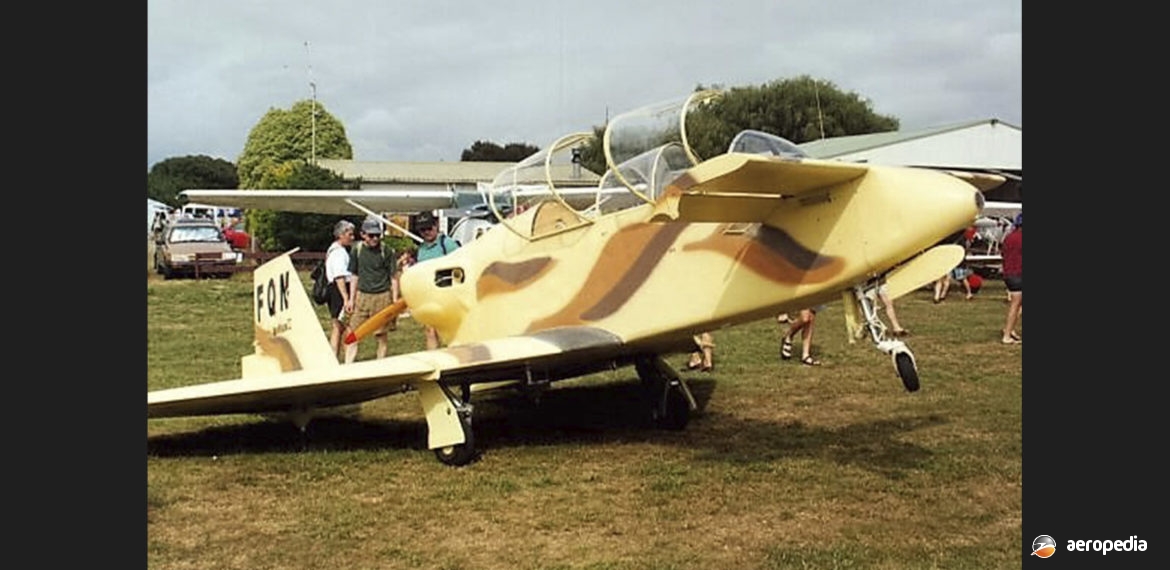Photograph:
Rutan Vari Viggen ZK-FQN (c/n AACA/254) at Matamata, NZ in February 1998 (Philip Treweek)
Country of origin:
United States of America
Description:
Two-seat light sport aircraft
Power Plant:
One 112 kw (150 hp) Avco Lycoming O-320-A2A four-cylinder horizontally-opposed air-cooled engine
Specifications:
- Wingspan: 5.79 m (19 ft 0 in)
- Length: 5.12 m (16 ft 10 in)
- Height: 1.88 m (6 ft 2 in)
- Wing area: 11.4 m² (123 sq ft)
- Max speed at sea level: 262 km/h (163 mph)
- Max cruising speed at 2,135 m (7,000 ft): 241 km/h (150 mph)
- Economical cruising speed: 201 km/h (125 mph)
- Landing speed: 72 km/h (45 mph)
- Max rate of climb at sea level: 244 m/min (800 ft/min)
- Service ceiling: 4,265 m (14,000 ft)
- Range with max fuel with 30 mins reserve: 643 km (400 miles)
- Empty weight: 431 kg (950 lb)
- Loaded weight: 771 kg (1,700 lb)
History:
Design of the Vari Viggen was commenced by Elbert ‘Bert’ Rutan in 1968 and the prototype, known as the Model 27, flew for the first time in May 1972. Flight tests proved the anticipated spin-free characteristics of the design, the philosophy being to provide a safe, docile aircraft with low-speed flying qualities rather than a high cruising speed. Having no conventional stall in its original form, it could not spin and the aircraft could climb, cruise, glide, turn and land with the stick fully back. The full-span ailerons provided a high rate of roll, and a 360 degrees roll could be performed at 148 km/h (92 mph) without loss of height.
In 1975 the Model 32 appeared. This varied from the Model 27 in having a new SP (special performance) wing. This was constructed from urethane foam and uni-directional fibreglass. With the span increased to 7.22 m (23 ft 8½ in), an increase in cruising speed and an increase in climb rate were provided, but the “no stall” feature disappeared. Subsequently winglets were fitted to the SP wing, improving directional stability.
The Vari Viggen was a cantilever low-wing monoplane of cropped delta configuration, the wings having spruce spars with plywood ribs and skin, and Ceconite covering. The outer panels were of flush riveted metal construction. The fuselage was of wooden construction with Ceconite covering. An electrically operated retractable tricycle undercarriage was fitted, with hydraulic brakes, and fuel capacity was 132 litres (29 Imp gals).
First of the type in this part of the world was built by Mr Desmond Whitfield and flew in New Zealand, becoming ZK-FQN (c/n AACA/254). However, during its flight testing the canopy detached when the aircraft was flying near Lake Rotorua on 6 October 1994, damaging the propeller, the aircraft ditching in the lake. The wreck was recovered and rebuilt in a period of 17 months. Tragically, on 28 August 1998 it crashed near Lake Rotoiti killing the pilot and passenger, the registration being cancelled on 27 July 1999.
Registration VH-DCA was reserved for an example construction of which was commenced in St Kilda, VIC by Mr J Day but is not known to have been completed. Construction of others commenced over the years, and one was nearing completion in Sydney, NSW in late 2008 but no further examples are known to have been completed.

